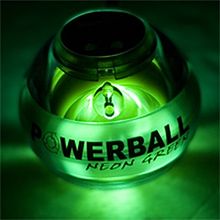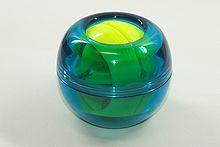- Gyroscopic exercise tool
-
A gyroscopic exercise tool is a device used to exercise the wrist as part of physical therapy or in order to build palm, forearm and finger strength. It can also be used as a unique demonstration of some aspects of rotational dynamics. The device consists of a tennis ball-sized plastic or metal shell around a free-spinning mass, which can be started with a short rip string or by a snap of the thumb. Once the gyroscope inside is going fast enough, a person holding the device can accelerate the spinning mass to high revolution rates by moving the wrist in a circular motion.
Contents
Mechanics
The device essentially consists of a spinning mass inside an outer shell. The shell almost completely covers the mass inside, with only a small round opening allowing the gyroscope to be manually started. The spinning mass is fixed to a thin metal axle, each end of which is trapped in a circular, equatorial groove in the outer shell. A lightweight ring with two notches in it for the ends of the axle rests in the groove. This ring can slip in the groove; it holds the spinning gyroscope centred in the shell, preventing the two from coming into contact (which would slow the gyro down), but still allowing the orientation of the axle to change.
Since the spinning mass is balanced, the only possibility to speed up the rotation is for the sides of the groove to exert forces on the ends of the axle. Furthermore, the normal and axial forces will have no effect, so tangential force must be provided by friction. If the axle is stationary, the friction will only act to slow down the rotation, but the situation is very different if the axle is turned by applying a torque.
This can be accomplished by tilting the shell in any direction except exactly in the plane of the groove, and results in a shift of the axle ends along the groove. The direction and speed of the shift can be found from the formula for the precession of a gyroscope: the applied torque is equal to the cross product of the angular velocity of precession and the angular momentum of the spinning mass. The most important observation here is that the direction is such that, if the torque is large enough, the friction between the axle and the surface of the groove will speed up the rotation.
This may seem odd. After all, if the axle were shifting in a horizontal groove, the friction on one end that acts to speed up the rotation would be canceled by the friction at the other end, operating in the opposite direction. The difference is that a torque is being applied, so one end of the axle is pushing against one side of the groove, while the other end is pushing against the other side. Likewise, it doesn't matter in which direction the torque is applied. If the torque is reversed, each end of the axle will then be pressing against the opposite side of the groove, but the direction of precession is also reversed. The only restriction is that the relative speed of the surface of the axle and the side of the groove due to precession, ΩPRgroove, must exceed the relative speed due to the rotation of the spinning mass, ωraxle. The minimum torque required to meet this condition is
 , where I is the moment of inertia of the spinning mass, and ω is its angular velocity.
, where I is the moment of inertia of the spinning mass, and ω is its angular velocity.Since an acceleration of the rotation will occur regardless of the direction of the applied torque, as long as it is large enough, the device will function without any fine-tuning of the driving motion. The tilting of the shell does not have to have a particular phase relationship with the precession or even to have the same frequency. Since sliding (kinetic) friction is usually nearly as strong as static (sticking) friction, it is also not necessary to apply precisely the value of torque which will result in the axle rolling without slipping along the side of the groove. These factors allow beginners to learn to speed up the rotation after only a few minutes of practice.
By applying the proportionality of the force of friction to the normal force, Ff = μkFn, where μk is the kinetic coefficient of friction, it can be shown that the torque spinning up the mass is a factor of
 smaller than the torque applied to the shell. Since frictional force is essential for the device's operation, the groove must not be lubricated.[1]
smaller than the torque applied to the shell. Since frictional force is essential for the device's operation, the groove must not be lubricated.[1]Models and manufacturers
Names under which gyroscopic exercise tools are sold include Powerball, "IronPower", DynaBee, NSD Powerball, NSD Power® Ball, as well as Dynaflex Powerball.
The Powerball brand is trademarked in the US by DynaFlex [2], and is manufactured by Nanosecond (NSD) in the US.
Gyroscopic wrist exercisers are used for therapeutic and endurance purposes and are highly favored by sports & fitness enthusiasts around the world, particularly those engaging in racket sports (tennis, badminton etc.), golf, rock climbing, motocross, cycling, baseball, hockey, martial arts etc.
In addition, the non impact nature of the products combined with the soothing resistance emitted by the spinning rotor have made them ideal rehabilitation devices for persons suffering from carpal tunnel syndrome, arthritis, RSI, bone breakage etc.
The light-emitting diodes are powered by a small generator embedded in the gyroscope. Even the original NSD Powerball includes the magnet needed to make the revolution counters work.[3] Other Powerball models on the market today include: the "Powerball 350Hz Metal" and "NSD SuperPowerBall" (these powerballs are made primarily of metal, have twice the weight of "regular" Powerball models and are more challenging to operate since up to 25 Nm of torque is produced); the "Powerball Signature" (featuring white LEDs) ; the "Powerball Screamer" (based on the Powerball 250 Hz model, but with 8 holes drilled in the rotor to generate a very loud sound) and the latest 'Autostart' Powerball model featuring an inbuilt rotor mechanism to allow easy starting of the device (no starting cord required for this model). Nanosecond's Powerball was the first to feature electronic revolution counters and a generator for light-emitting diodes and made its market debut in or around 1997
RPM Sports Records
Competition has evolved around the electronic counters that feature on some Powerball products. The current records for NSD model PB-188C ball are 16,732 rpm peak7,561 revolutions in 30 seconds, 21,228 revolutions in 90 seconds, and a combined 31,816 rpm in the Dual category (one Powerball in each hand). The peak speed record for PB-388C ball is 14,091 rpm and the he peak speed record for PB-388HC ball is 20,090 rpm.
All of the above records are currently held by Akis Kritsinelis from Greece.[4] Other scoreboards register higher scores[5]
Patents
The device is covered by US patents 3,726,146 (1973) and 5,353,655 (1994) by L.A. Mishler and US patent 5,800,311 (1998) by P.S.Chuang and 6,942,601 (2001) by P.S. Chuang.
References
- ^ Articles on the physics of the device (in approximately increasing order of sophistication):
- J.Higbie, ‘The physics of the “Dyna Bee”’, The Physics Teacher, 18, 147–148 (1980).
- P.G.Heyda, ‘Roller ball dynamics’, Mathematics Today, 36, 9 (2000).
- P.G.Heyda, ‘Roller ball dynamics revisited’, American Journal of Physics, 70, 1049–1051 (2002).
- D.W.Gulick & O.M.O’Reilly, ‘On the Dynamics of the Dynabee’, ASME Journal of Applied Mechanics, 67, 321–325 (2000).
- ^ http://iprs.cbp.gov/index.asp?action=detail&id=105377&searchArg=CHENG&page=1
- ^ SourceForge revolution counter project
- ^ scoreboard managed by RPM Sports.
- ^ scoreboard managed by RPM Sports' official partner Gross-Snab contains the score of 16973 rpm achieved on PB-188LC ball (PB-188C with LEDs).
External links
- Official Powerball website and Shop
- Dyna-Flex Gyros
- GyroTwister website
- Gyrotek Powerball Fan Site
- NSD Powerball Gyroscope Review
- Nanosecond website
- Review & Explanation of GyroTwister & Powerball
- Disassembled Powerball
- Proof of patents and principle of working PDF in German
- Powerball - the Original
- Gyroscopic Bowl
Categories:- Physical activity and dexterity toys
- ^ Articles on the physics of the device (in approximately increasing order of sophistication):
Wikimedia Foundation. 2010.


